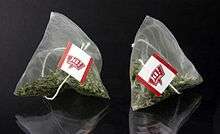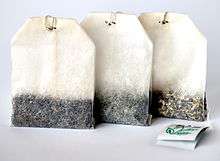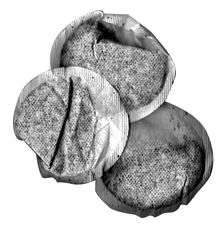Tea bag
A tea bag is a small, porous, sealed bag or packet, typically containing tea leaves, which is immersed in water to steep and make an infusion. Originally used only for tea (Camellia sinensis), they are now made with other tisanes as well.


Tea bags are commonly made of filter paper or food-grade plastic, or occasionally of silk cotton or silk. The tea bag performs the same function as a tea infuser. Tea bags can be used multiple times until there is no extraction left. Some tea bags have an attached piece of string with a paper label at the top that assists in removing the bag, while also displaying the brand or variety of tea.
History
Tea bag patents date from 1903,[1] and the first modern tea bags were hand-sewn fabric bags. Appearing commercially around 1904, tea bags were successfully marketed in about 1908 by Thomas Sullivan, a tea and coffee importer from New York, who shipped his silk tea bags around the world.[2] The loose tea was intended to be removed from the bags by customers, but they found it easier to brew the tea with the tea leaves still enclosed in the porous bags.[3] The first tea bag packing machine was invented in 1929 by Adolf Rambold for the German company Teekanne.[4]
The heat-sealed paper fiber tea bag was patented in 1930 by William Hermanson.[5] The now-common rectangular tea bag was not invented until 1944. Prior to that, tea bags resembled small sacks.[6]
Production
Teas
A broad variety of teas as well as other infusions like herbal teas, are available in tea bags. Typically, tea bags use fannings, the left-overs after larger leaf pieces are gathered for sale as loose tea, but some companies sell teabags containing whole-leaf tea.[7]
Shapes and use


Traditionally, tea bags have been square or rectangular in shape. More recently circular and tetrahedral bags have come on the market and are often claimed by their manufacturers to improve the quality of the brew. Environmentalists prefer silk to nylon because of health and biodegradability issues.[8] Another material for tea bags is Soilon (PLA mesh), made from corn starch.[9] Empty tea bags are also available for consumers to fill with tea leaves themselves. These are typically open-ended pouches with long flaps. The pouch is filled with an appropriate quantity of leaf tea and the flap is closed into the pouch to retain the tea. Such tea bags combine the ease of use of a commercially produced tea bag with the wider tea choice and better quality control of loose leaf tea.
Materials used
Tea bag paper is related to paper found in milk and coffee filters and is a blend of wood and vegetable fibers. The latter is bleach pulp abaca hemp, a plantation banana plant grown for its fiber, mostly in the Philippines and Colombia. Some bags have a heat-sealable thermoplastic such as PVC or polypropylene as a component fiber on the inner tea bag surface, and other bags are made from nylon.[10] Paper tea bags are commonly sealed using polypropylene.[11]
Controversies regarding the use of plastic in teabags
Non biodegradability
In 2017, Mike Armitage, a gardener in Wrexham, UK, found that tea bags left a plastic residue after being composted. He started a petition urging Unilever to remove plastic from bag production.[12][13][14] In January 2018, Co-op Food announced that they were removing plastic from their own brand 99 tea bags in conjunction with their supplier Typhoo.[15][16] In February 2018, PG Tips announced that their pyramid bags now use corn starch adhesive in place of polypropylene.[12][17][18]
Release of microplastics
Even before composting, microplastics may be found in the tea meant for human consumption. A 2019 study showed that "steeping a single plastic teabag at brewing temperature (95 °C) releases approximately 11.6 billion microplastics and 3.1 billion nanoplastics into a single cup of the beverage".[19][20]
Coffee bags
The concept of pre-measured portions to be infused in disposable bags has also been applied to coffee in the form of the coffee bag, although this has not achieved such wide acceptance as the tea bag.
Tea bag-related activities
Decorative tea bags have become the basis for large collections and many collectors collect tea bags from around the world. Tea bag collector clubs are widely spread around the world and members consist of people interested in items related to teas. Online collector clubs often include catalogs of tea bags[21], as well as collection tracking tools. In addition, tea bag collectors often collect other tea-related items such as labels.[22] These websites also provide forums for discussions and trade arrangements between collectors.
Teabag folding began in the Netherlands and is often credited to Tiny van der Plas. It is a form of origami in which identical squares of patterned paper (cut from the front of tea bag wrappers) are folded, and then arranged in rosettes. These rosettes are usually used to decorate gift cards and it has become a popular craft in both the US and UK since 2000.[23]
Soil scientists used standardized tea bags to measure the decomposition rate of organic materials in different soils.[24][25]
See also
- 3-MCPD, a chemical compound that is carcinogenic, and can occur in some resin-reinforced tea bag materials
- Builder's tea, refers to a basic method of preparing tea in a mug with tea bags
- Tea leaf grading
- Tea strainer, a small mesh utensil that can filter out stray tea leaves when whole-leaf tea is poured from a teapot
- Tetley, the British tea company that introduced tea bags in the United Kingdom in 1953
References
- "Tea-leaf holder". USPTO. Retrieved 25 October 2013. US patent 723287 was issued on MAR. 24, 1903 to R. G.LAWSON & M. McLAREN for a 'novel tea-holding pocket constructed of open-mesh woven fabric, inexpensively made of cotton thread'.
- Begley, Sarah (3 September 2015). "The History of the Tea Bag". Time.
- Editors, Time-Life (1991). Inventive Genius. New York: Time-Life Books. p. 99. ISBN 0-8094-7699-1.CS1 maint: extra text: authors list (link)
- Rexing, Bernd (2011-05-14). "14. Mai 1996 - Teebeutel-Entwickler Adolf Rambold stirbt" (in German). Retrieved 2018-08-03.
- Bloxham, Andy (2008-06-13). "Tea bag to celebrate its century". Telegraph.co.uk. Retrieved 2009-07-15.
- Dubrin, Beverly (2010). Tea Culture: History, Traditions, Celebrations, Recipes & More. Charlesbridge Publishing, p. 35. ISBN 1607343630
- Fabricant, Florence (2000-02-09). "Whole Leaves, No Strings For a New Tea Bag". The New York Times. Retrieved 2009-07-15.
- Fabricant, Florence (September 13, 2006). "Tea's Got a Brand New Bag". The New York Times.
- "Tea Stick Brewing Package and Method". Freepatentsonline.com. Retrieved 2018-08-16.
- Smithers, Rebecca (2 July 2010). "Most UK teabags not fully biodegradeable, research reveals". the Guardian.
- "Composting teabags – Which? News". Which? News. 2010-07-02. Retrieved 2018-03-26.
- "Remove plastics from PG Tips tea bags". Campaigns by You. Retrieved 2018-03-26.
- "Teabags 'a cause of plastic pollution'". BBC News. 2017-12-19. Retrieved 2018-03-26.
- "PG Tips teabags to be made plastic-free". BBC News. 2018-02-28. Retrieved 2018-03-26.
- "The New 'Green' Tea: Co-op Brews Up Solution To Plastic Tea Bags". Retrieved 2018-03-26.
- Smithers, Rebecca (2018-01-28). "An eco-friendly cuppa? Now teabags are set to go plastic-free". the Guardian. Retrieved 2018-03-26.
- "What We're Doing with Our New Decaf Tea Blend – PG tips". PG Tips. Retrieved 2018-03-26.
- Smithers, Rebecca (2018-02-28). "PG tips announces switch to plastic-free fully biodegradable teabags". the Guardian. Retrieved 2018-03-26.
- Chung, Emily (25 September 2019). "Some tea bags may shed billions of microplastics per cup". CBC News. Retrieved 25 September 2019.
- Hernandez LM, Xu EG, Larsson HC, Tahara R, Maisuria VB, Tufenkji N (25 September 2019). "Plastic Teabags Release Billions of Microparticles and Nanoparticles into Tea". Environmental Science & Technology. 53 (21): 12300–12310. doi:10.1021/acs.est.9b02540. PMID 31552738.
- "Tea Bags on Colnect". colnect.com. Retrieved 2018-12-18.
- "Tea Labels on Colnect". colnect.com. Retrieved 2019-03-01.
- jbritton (2009-06-29). "Tea bag folding". Britton.disted.camosun.bc.ca. Archived from the original on 2009-08-03. Retrieved 2009-07-15.
- Keuskamp, Joost A. (July 2013). "Tea Bag Index: a novel approach to collect uniform decomposition data across ecosystems". Methods in Ecology and Evolution. 4 (11): 1070–1075. doi:10.1111/2041-210X.12097.
- Ogden, Lesley Evans (5 June 2019). "How teabags became a secret weapon in the fight against climate change". New Scientist. Retrieved 31 July 2019.
External links
![]()